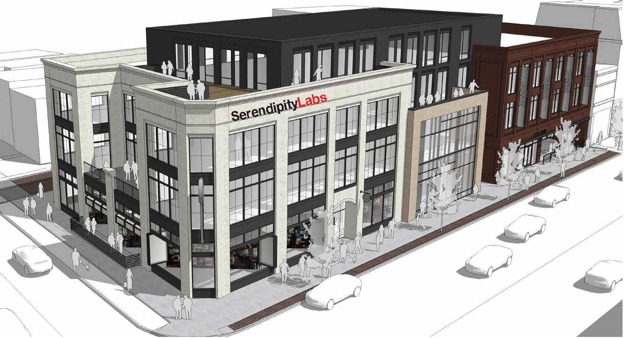 The vision for 900 N. High St. in Columbus’ Short North neighborhood, where co-working provider Serendipity Labs will have 22,000 square feet.
The vision for 900 N. High St. in Columbus’ Short North neighborhood, where co-working provider Serendipity Labs will have 22,000 square feet.
CHICAGO, COLUMBUS—The US workplace has changed quite a bit in the last few years, with many firms ditching the traditional office space in favor of collaborative environments chockablock with amenities. And this approach has been adopted by many types of businesses throughout the nation, including those in non-core markets, according to CBRE’s 2017 Midwest Trends Report.
“It’s not just tech companies and advertising firms,” Phillip Pelok, a Columbus-based senior vice president with CBRE, tells GlobeSt.com. “It’s industry wide. Even law firms, who still need a lot of private offices, are creating more collaborative areas.”
CBRE surveyed 176 corporate real estate executives, and two trends stood out: building a “workplace experience” and “right-sizing the footprint.” Creating a new way of organizing an office is especially popular. Of those surveyed, 86% say they are already reinventing their workspaces to allow more collaboration. And 64% identified amenities as the chief concern for employees, especially “cutting edge” ones such as hospitality concierge services.
That level of service has also become more common among co-working providers such as WeWork and Convene. Their spaces cater to the whims of a wide range of office users, and have spread far and wide. “Co-working used to mostly be about entrepreneurs and start-ups,” Pelok says, “but today, a lot of corporate clients have contracts with these providers.” And instead of putting capital into new office space, as well as the time and trouble of negotiating a lease, a firm can essentially dial up a co-working provider when it needs to open an office.
But their employees expect something more than a few desks, phones and a break room with nothing more than a microwave. “What they’re looking for is a real café, something that will provide an experience,” Pelok says. And the best places “don’t have a receptionist; they have a concierge.”
These co-working firms are having a wider impact on the office world, although Pelok does not believe they are the only, or even chief, factor changing office design. But today’s co-working facilities do put pressure on traditional firms by raising expectations for everyone. And that’s happening in most Midwest office markets, not just top metros like Chicago.
Data collected by CBRE Research show the Chicago region has two million square feet of co-working space and a total of 85 facilities. But Columbus has nearly 500,000 square feet of space devoted to co-working, and a total of 43 facilities. And Columbus is not unusual in this respect. Indianapolis, Detroit, Kansas City, St. Louis and Minneapolis each have dozens of facilities and up to 700,000 square feet.

















 Copyright © 2024 ALM Global, LLC. All Rights Reserved.
Copyright © 2024 ALM Global, LLC. All Rights Reserved.